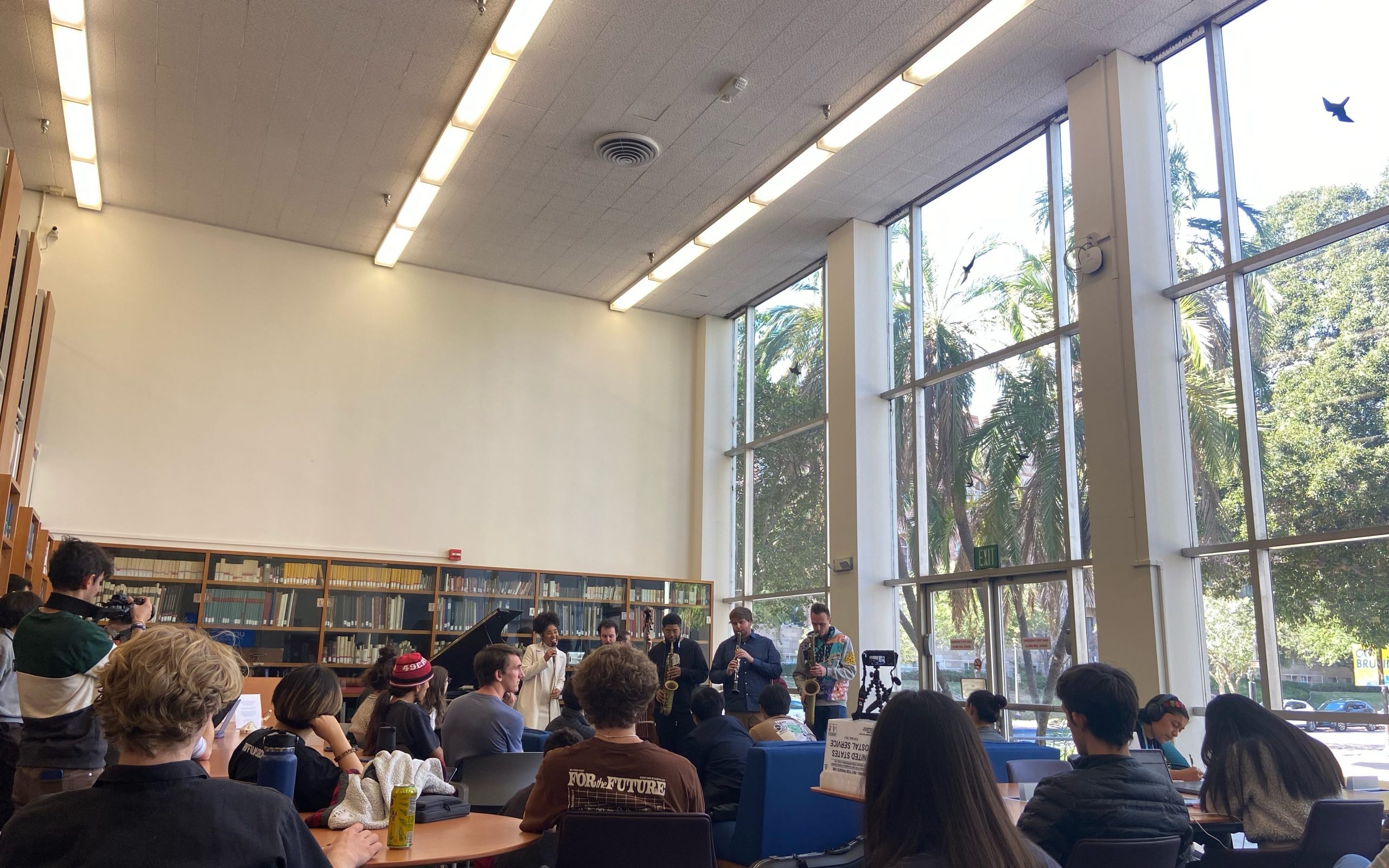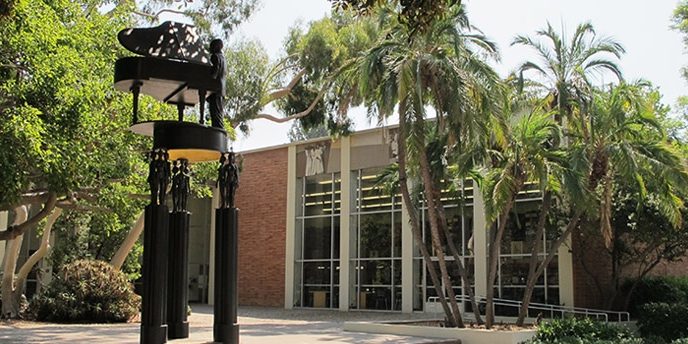Herbie Hancock Institute of Jazz @ The Music Library [11/4/22]
Header photo credit: UCLA Library
Ah, the library: a place of books and manuscripts. Of scholarly dedication. Of ungodly amounts of vending-machine-coffee consumption. And, at UCLA, of afternoon jam sessions, courtesy of the Herbie Hancock Institute of Jazz Performance.
It’s Friday, and my friend Ella and I are taking a break between lectures to catch said session for her ethnomusicology class. I’m tense; I’ve got upcoming midterms, late assignments, and Runge-Kutta on my mind. But as we take a seat in the back of the already-packed Music Library, there’s a change in the air. Housed in the modernist Schoenberg Music Building, the library’s floor-to-ceiling windows allow for an abundance of natural light, warming the audience: People are slouching in chairs, lounging on couches, and making friendly conversation while the musicians set up their instruments. Gone is the state-mandated, stress-inducing silence typical of libraries. Today, it’s a sanctum strictly for the pleasure of music.
As the chatter dies down, someone introduces the ensemble: each year, The Herbie Hancock Institute of Jazz Performance accepts an ensemble of musicians for a two-year program of intensive jazz study. This year’s graduating class consists of Darynn Dean (vocals), Matthew Stubbs (clarinet), Devin Daniels (alto sax), Art Baden (tenor sax), Julien Knowles (trumpet), Emiliano Lasansky (bass), Javier Santiago (piano), and Benjamin Ring (drums).
The first original piece begins with Lasansky’s lone bass intro, setting a foundation for Santiago’s piano line to stroll in. The rest of the ensemble wakes up over an indeterminate beat, shaping a bright, action-packed texture. As the bass, piano, and drums conjure up a storm of rhythm and percussion, the members arrange themselves in a horizontal line for their solos, mirroring the feeling of constant linear motion throughout the song. Altogether, the ensemble crafts a piece of movement, flaring up and down, but always forward, not unlike the way your attention catches and wanders while walking through a lively downtown street – it’s exciting, it’s adventurous, and most of all, it demands an absolute surrender from any worries on your mind, in favor of an unadulterated enjoyment of jazz.
The ensemble is quieter at the start of the second original composition, playing with a sense of tentative anticipation. This all cracks open with a defining solo by the tenor saxophonist. For around two minutes, Baden’s sax screeches, pounces, and buoys its way through a thick ether, emerging victorious to the other side. If Paul Desmond’s sax sounded like a dry martini, Baden’s is analogous to the first sip of an Old-Fashioned: sweet-yet-spicy, with just enough sharp edges to warble on your tongue and douse it in melodic viscosity. Near the end of the solo, an audience member in the front row shakes his head, as if in disbelief that music could shape itself like that. The student next to me gently bobs her own as she works out a problem set. I’d like to think both listeners equally appreciated the piece, albeit in different ways.
After the ensemble finishes the piece, the student jam sessions commence, launching into well-known jazz standards such as “Four” and “There Will Never Be Another You.” Watching the musicians play, it’s not just their zest for jazz that’s palpable, but their camaraderie with each other; during the bassist’s solo on “There Will Never Be Another You,” the horn players turn themselves to face him, nearly boxing him in in an act of admiration. Though he shows no hesitancy in his playing, his fingers moving rapidly as if the strings were made of freshly-shaped steel, I wonder: is this nerve-wracking for him?
“Not really,” he laughs, when I ask him about it a few days later. “I’ve been playing jazz for so many years, something like that… I’m not intimidated by anything anymore.” Matthew Wilson, a third-year Global Jazz Studies major, has been playing jazz bass since middle school. He explains that this behavior is pretty normal in most jazz performances – a common courtesy, of sorts. “If someone else is soloing, you’re gonna watch them and appreciate their playing.”
Beyond jazz, Wilson also plays gigs for rock and reggae bands. “One thing I really love about UCLA’s music community is how much it embraces different music styles,” he shares. “In a lot of music communities, there’s the impression that they’re delegated to one style of music or concept, only focusing on classical music, or jazz… But here at UCLA, it seems like the people are into every [style] to some degree – which is great for me, because I’m one of those people.”
Today’s jam session proves his statement true: whether they were letting the melodies flow through their bodies like a conduit or simply using it as a backdrop study beat, it felt like all library patrons got something out of the jazz music. For an afternoon, the Music Library invited jazz buffs, stressed students, and everyone in between to pause their busy days and listen to some talented musicians do what they do best: express themselves and connect with others through song. The act of living can be overwhelming, but it’s in places like these —- of warm natural lighting, of live music, of living for music – that remind us “it’s worth it to be in a body.” And hey – I’ll take it, even if it’s just for an hour or two. If only studying at the library was always this cool.





